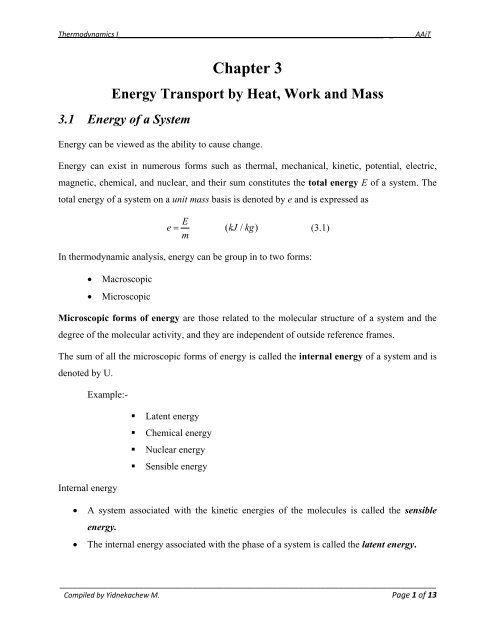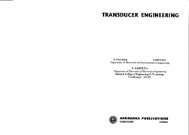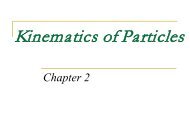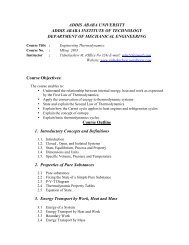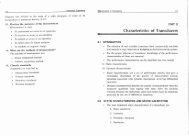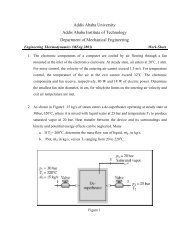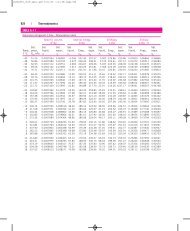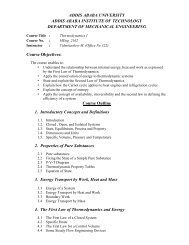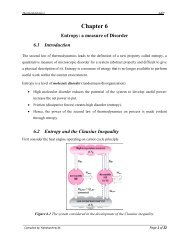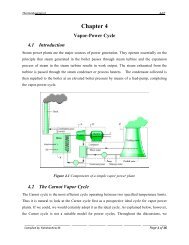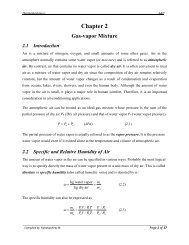Energy Transport by Heat, Work and Mass.pdf - Yidnekachew
Energy Transport by Heat, Work and Mass.pdf - Yidnekachew
Energy Transport by Heat, Work and Mass.pdf - Yidnekachew
You also want an ePaper? Increase the reach of your titles
YUMPU automatically turns print PDFs into web optimized ePapers that Google loves.
Thermodynamics I__________________________________________________________________ _<br />
AAiT<br />
Chapter 3<br />
<strong>Energy</strong> <strong>Transport</strong> <strong>by</strong> <strong>Heat</strong>, <strong>Work</strong> <strong>and</strong> <strong>Mass</strong><br />
3.1 <strong>Energy</strong> of a System<br />
<strong>Energy</strong> can be viewed as the ability to cause change.<br />
<strong>Energy</strong> can exist in numerous forms such as thermal, mechanical, kinetic, potential, electric,<br />
magnetic, chemical, <strong>and</strong> nuclear, <strong>and</strong> their sum constitutes the total energy E of a system. The<br />
total energy of a system on a unit mass basis is denoted <strong>by</strong> e <strong>and</strong> is expressed as<br />
E<br />
e ( kJ / kg )<br />
(3.1)<br />
m<br />
In thermodynamic analysis, energy can be group in to two forms:<br />
<br />
<br />
Macroscopic<br />
Microscopic<br />
Microscopic forms of energy are those related to the molecular structure of a system <strong>and</strong> the<br />
degree of the molecular activity, <strong>and</strong> they are independent of outside reference frames.<br />
The sum of all the microscopic forms of energy is called the internal energy of a system <strong>and</strong> is<br />
denoted <strong>by</strong> U.<br />
Example:-<br />
• Latent energy<br />
• Chemical energy<br />
• Nuclear energy<br />
• Sensible energy<br />
Internal energy<br />
<br />
<br />
A system associated with the kinetic energies of the molecules is called the sensible<br />
energy.<br />
The internal energy associated with the phase of a system is called the latent energy.<br />
_____________________________________________________________________________________<br />
Compiled <strong>by</strong> <strong>Yidnekachew</strong> M. Page 1 of 13
Thermodynamics I__________________________________________________________________ _<br />
AAiT<br />
The internal energy associated with the atomic bonds in a molecule is called chemical<br />
energy.<br />
The tremendous amount of energy associated with the strong bonds within the nucleus of<br />
the atom itself is called nuclear energy.<br />
The total energy of a system, can be contained or stored in a system, <strong>and</strong> thus can be<br />
viewed as the static forms of energy.<br />
The forms of energy not stored in a system can be viewed as the dynamic forms of<br />
energy.<br />
The only two forms of energy interactions associated with a closed system are heat<br />
transfer <strong>and</strong> work.<br />
Macroscopic forms of energy are those a system possesses as a whole with respect to some<br />
outside reference frame, such as kinetic <strong>and</strong> potential energies.<br />
The energy that a system possesses as a result of its motion relative to some reference<br />
frame is called kinetic energy (KE) <strong>and</strong> is expressed as<br />
2<br />
V<br />
KE m<br />
2<br />
( kJ ) (3.2)<br />
Per unit mass<br />
<br />
2<br />
V<br />
ke ( kJ / kg ) (3.3)<br />
2<br />
The energy that a system possesses as a result of its elevation in a gravitational field is<br />
called potential energy (PE) <strong>and</strong> is expressed as<br />
Per unit mass<br />
PE<br />
pe<br />
mgz ( kJ ) (3.4)<br />
gz<br />
( kJ ) (3.5)<br />
The magnetic, electric, <strong>and</strong> surface tension effects are significant in some specialized cases only<br />
<strong>and</strong> are usually ignored. In the absence of such effects, the total energy of a system consists of<br />
the kinetic, potential, <strong>and</strong> internal energies <strong>and</strong> is expressed as<br />
E U KE<br />
PE<br />
_____________________________________________________________________________________<br />
Compiled <strong>by</strong> <strong>Yidnekachew</strong> M. Page 2 of 13
Thermodynamics I______ _____________________________________________________________ _<br />
AAiT<br />
E<br />
U<br />
V<br />
m<br />
2<br />
2<br />
mgz<br />
(kJJ<br />
)<br />
(3.6)<br />
Per unit mass<br />
e uke<br />
pe<br />
Most closed systemss remain stationary during a processs <strong>and</strong> thus experience no<br />
change in their<br />
kinetic <strong>and</strong> potential energies.<br />
e<br />
u<br />
2<br />
V<br />
gz<br />
2<br />
Closed systems whose velocity <strong>and</strong> elevation of the center of gravity remain constant during a<br />
process are frequently referred to<br />
as stationary systems. The change in the total energy ∆EE of a<br />
stationary<br />
system is identical to the change in<br />
its internal<br />
energy ∆U. .<br />
3.2 <strong>Energy</strong> transport <strong>by</strong> heat <strong>and</strong> work<br />
(kJJ<br />
/ kg)<br />
(3.7)<br />
<strong>Energy</strong> can cross the boundary of a closed system in two<br />
distinct forms: heat <strong>and</strong><br />
work.<br />
Figure 3.1 <strong>Energy</strong> can cross the boundaries of a closed system in the<br />
form of heat <strong>and</strong> work.<br />
<strong>Energy</strong><br />
transportt <strong>by</strong> heat<br />
<strong>Heat</strong> is defined as the form of energy that is transferred between two<br />
systems (or<br />
a system <strong>and</strong> its<br />
surroundings) <strong>by</strong> virtue of a temperature difference.<br />
_____________________________________________________________________________________<br />
Compiled<br />
<strong>by</strong> <strong>Yidnekachew</strong> M.<br />
Page 3 of 13
Thermodynamics I______ _____________________________________________________________ _<br />
AAiT<br />
Figure 3.2 <strong>Heat</strong> transferr from hot surface to cold<br />
surface<br />
That is, an energy interaction is heat only if it takes place<br />
because of<br />
a temperature difference.<br />
Then it follows that there cannot be any heat<br />
transfer between two systems that are at the same<br />
temperature.<br />
A process during which there is no heat transfer is called an adiabatic process. The<br />
adiabatic<br />
comes from<br />
the Greek word adiabatos, which means not to<br />
be passed.<br />
word<br />
There are<br />
two ways a process can be adiabatic: Either the system is well insulated so that only a<br />
negligible amount of heat can<br />
pass through the boundary, or<br />
both the system <strong>and</strong><br />
the<br />
surroundings are at the same temperature <strong>and</strong> thereforee there is no<br />
driving force (temperature<br />
difference) for heat transfer.<br />
Figure 3.3 During an<br />
adiabatic process, a system exchanges no heat with its surroundings.<br />
As a form<br />
of energy,<br />
heat has energy units, kJ being the most common one. The amount of<br />
heat<br />
transferred during the process between two states (states 1 <strong>and</strong> 2) is denoted <strong>by</strong> Q 12 , or just Q.<br />
<strong>Heat</strong> transfer per unit mass of a system is denoted q <strong>and</strong> is determined from<br />
Q<br />
q ( kJ / kg)<br />
(3.8)<br />
m<br />
_____________________________________________________________________________________<br />
Compiled<br />
<strong>by</strong> <strong>Yidnekachew</strong> M.<br />
Page 4 of 13
Thermodynamics I__________________________________________________________________ _<br />
AAiT<br />
Sometimes it is desirable to know the rate of heat transfer (the amount of heat transferred per<br />
unit time) instead of the total heat transferred over some time interval.<br />
Figure 3.4 The relationships among q, Q, <strong>and</strong> Q .<br />
The heat transfer rate is denoted , where the overdot st<strong>and</strong>s for the time derivative, or “per unit<br />
time.” The heat transfer rate has the unit kJ/s, which is equivalent to kW. When varies with<br />
time, the amount of heat transfer during a process is determined <strong>by</strong> integrating over the time<br />
interval of the process:<br />
Q <br />
t <br />
2<br />
t1<br />
Qdt<br />
( kJ ) (3.9)<br />
When remains constant during a process, this relation reduces to<br />
Where: t t2 t1<br />
Q Q t<br />
( kJ ) (3.10)<br />
<strong>Heat</strong> is transferred <strong>by</strong> three mechanisms: conduction, convection, <strong>and</strong> radiation. Conduction is<br />
the transfer of energy from the more energetic particles of a substance to the adjacent less<br />
energetic ones as a result of interaction between particles. Convection is the transfer of energy<br />
between a solid surface <strong>and</strong> the adjacent fluid that is in motion, <strong>and</strong> it involves the combined<br />
effects of conduction <strong>and</strong> fluid motion. Radiation is the transfer of energy due to the emission of<br />
electromagnetic waves (or photons).<br />
<strong>Energy</strong> <strong>Transport</strong> <strong>by</strong> <strong>Work</strong><br />
<strong>Work</strong>, like heat, is an energy interaction between a system <strong>and</strong> its surroundings. As mentioned<br />
earlier, energy can cross the boundary of a closed system in the form of heat or work. Therefore,<br />
_____________________________________________________________________________________<br />
Compiled <strong>by</strong> <strong>Yidnekachew</strong> M. Page 5 of 13
Thermodynamics I__________________________________________________________________ _<br />
AAiT<br />
If the energy crossing the boundary of a closed system is not heat, it must be work. <strong>Work</strong> is the<br />
energy transfer associated with force acting through a distance.<br />
Example:-<br />
• A rising piston<br />
• A rotating shaft<br />
<strong>Work</strong> is also a form of energy transferred like heat <strong>and</strong>, therefore, has energy units such as kJ.<br />
The work done during a process between states 1 <strong>and</strong> 2 is denoted <strong>by</strong> W 12 , or simply W. The<br />
work done per unit mass of a system is denoted <strong>by</strong> w <strong>and</strong> is expressed as<br />
W<br />
w ( kJ / kg )<br />
(3.11)<br />
m<br />
The work done per unit time is called power <strong>and</strong> is denoted <strong>by</strong> . The unit of power<br />
is kJ/s, or kW.<br />
<strong>Heat</strong> <strong>and</strong> work are energy transfer mechanisms between a system <strong>and</strong> its surroundings, <strong>and</strong> there<br />
are many similarities between them:<br />
Both are recognized at the boundaries of a system as they cross the boundaries. That is,<br />
both heat <strong>and</strong> work are boundary phenomena.<br />
Systems possess energy, but not heat or work.<br />
Both are associated with a process, not a state. Unlike properties, heat or work has no<br />
meaning at a state.<br />
Both are path functions (i.e., their magnitudes depend on the path followed during a<br />
process as well as the end states).<br />
Sign convention for energy transported <strong>by</strong> heat <strong>and</strong> work<br />
<strong>Heat</strong> <strong>and</strong> work are directional quantities, <strong>and</strong> thus the complete description of a heat or work<br />
interaction requires the specification of both the magnitude <strong>and</strong> direction. One way of doing that<br />
is to adopt a sign convention. The generally accepted formal sign convention for heat <strong>and</strong> work<br />
interactions is as follows: heat transfer to a system <strong>and</strong> work done <strong>by</strong> a system are positive; heat<br />
transfer from a system <strong>and</strong> work done on a system are negative. Another way is to use the<br />
subscripts in <strong>and</strong> out to indicate direction<br />
_____________________________________________________________________________________<br />
Compiled <strong>by</strong> <strong>Yidnekachew</strong> M. Page 6 of 13
Thermodynamics I______ _____________________________________________________________ _<br />
AAiT<br />
Figure 3.5 Specifying the directions of heat <strong>and</strong> work.<br />
Q in > 0 <strong>Heat</strong> transfer to a system (positive)<br />
Q out < 0 <strong>Heat</strong> transfer from a system (negative)<br />
Figure 3.6 Process from<br />
stage 1 to 2 Figure 3.7 Process from stage 1 to 2<br />
W ><br />
W <<br />
0 work done <strong>by</strong> the system (positive) Figure 3.6<br />
0 work done on the system (negative) Figure 3.7<br />
Path functions have<br />
inexact differentials designated <strong>by</strong><br />
the symbol . Therefore, a differential<br />
amount of heat or work is represented <strong>by</strong><br />
Q or W, respectively, instead<br />
of dQ or<br />
dW.<br />
Properties, however, are point functions (i.e., they depend on the state only, <strong>and</strong> not on how a<br />
system reaches that state), <strong>and</strong> they have exact differentials designated <strong>by</strong> the symbol d.<br />
A small change in volume, for example, is represented <strong>by</strong> dv, <strong>and</strong> the<br />
total volume change during<br />
a processs between states 1 <strong>and</strong> 2 is<br />
2<br />
1 dv<br />
v<br />
v<br />
v<br />
2 1<br />
(3.12)<br />
_____________________________________________________________________________________<br />
Compiled<br />
<strong>by</strong> <strong>Yidnekachew</strong> M.<br />
Page 7 of 13
Thermodynamics I______ _____________________________________________________________ _<br />
AAiT<br />
Figure 3.8 Properties are point functions; but heat <strong>and</strong> work are path functions<br />
The total<br />
work done during process 1–2, however, is<br />
<br />
1<br />
2<br />
W<br />
<br />
W (not<br />
W)<br />
12<br />
(3.13)<br />
That is, the total work is obtained <strong>by</strong> following the process path<br />
<strong>and</strong> adding<br />
the differential<br />
amounts of work (W) done along the way. The integral of W is not W 2 - W 1 (i.e., the work at<br />
state 2 minus work at state 1), which is meaningless since work is not a property<br />
<strong>and</strong> systems do<br />
not possess work at a state.<br />
3.3 Boundary<br />
work<br />
The work associated<br />
with a moving boundary is called boundary<br />
work. The expansionn <strong>and</strong><br />
compression work is often called moving boundary work or simply boundary work.<br />
Example:- piston–cylinder<br />
device.<br />
Figure 3.9 The work associated with a moving boundary is called boundary work.<br />
_____________________________________________________________________________________<br />
Compiled<br />
<strong>by</strong> <strong>Yidnekachew</strong> M.<br />
Page 8 of 13
Thermodynamics I______ _____________________________________________________________ _<br />
AAiT<br />
In this section, we analyze the moving boundary work for a quasiequilibrium process, a process<br />
during which the system remains<br />
nearly in equilibrium at all times. A quasi-equilibrium process,<br />
Boundary<br />
work is done <strong>by</strong> the steam on the piston is calculated from<br />
figure 3.10.<br />
Figure 3.10 The area under the process curve on a P-V<br />
diagram represents the boundary work.<br />
Wb<br />
<br />
W b<br />
<br />
1<br />
2<br />
Fd<br />
2<br />
Wb<br />
<br />
W b<br />
s<br />
<br />
1 PdV<br />
F<br />
Ads PdV<br />
A<br />
(3.14)<br />
(3.15)<br />
(3.16)<br />
This integral can be<br />
evaluated<br />
during the process.<br />
only if we<br />
know the functional relationship between P <strong>and</strong> v<br />
P= f (V) is simply the equation of the process path on a P-V diagram. The differential area dA is<br />
equal to PdV. The total area A under the<br />
process curve 1–2 is<br />
obtained <strong>by</strong> adding these<br />
differential areas:<br />
Area<br />
A<br />
<br />
A comparison of this equation with the above ( Wb<br />
<br />
1<br />
2<br />
dA <br />
1<br />
2<br />
PdV<br />
( 3.17)<br />
2<br />
1<br />
PdV ), reveals that the<br />
area under the<br />
process curve on a P-v diagram is equal,<br />
in magnitude, to the work done during a quasi-<br />
_____________________________________________________________________________________<br />
Compiled<br />
<strong>by</strong> <strong>Yidnekachew</strong> M.<br />
Page 9 of 13
Thermodynamics I______ _____________________________________________________________ _<br />
AAiT<br />
equilibrium expansion or compression process of a closed system. (On the<br />
represents the boundary work done per unit mass.)<br />
P-v diagram, it<br />
Some typical process<br />
Wb<br />
<br />
Boundary work at constant volume process<br />
1<br />
2<br />
PdV<br />
(3.18)<br />
Figure 3.11 Schematic <strong>and</strong> P-V<br />
diagram for constant pressure process<br />
If the volume is held constant, =0 <strong>and</strong> the boundary work equation becomes<br />
W<br />
Boundary work at constant pressure<br />
b<br />
<br />
<br />
1<br />
2<br />
PdV<br />
0<br />
(3.19)<br />
Figure 3.12<br />
Schematic <strong>and</strong> P-v diagram for constant pressure<br />
_____________________________________________________________________________________<br />
Compiled <strong>by</strong> <strong>Yidnekachew</strong> M.<br />
Page 10<br />
of 13
Thermodynamics I______ _____________________________________________________________ _<br />
AAiT<br />
If the pressure is held constant the boundary<br />
work equation becomes.<br />
Wb<br />
<br />
1<br />
2<br />
PdV P dV<br />
PV ( <br />
V (3.20)<br />
Boundary work at constant temperature (Isothermal)<br />
<br />
1<br />
2<br />
2<br />
1 )<br />
Figure 3.13 Schematic <strong>and</strong> P-V diagram<br />
for a polytropic process.<br />
If the temperature of<br />
an ideal gas<br />
system held<br />
constant, then the equation of state<br />
provides the<br />
pressure volume relation.<br />
mRT<br />
P <br />
V<br />
(3.21)<br />
The boundary work is:<br />
2<br />
Wb<br />
<br />
PdV But<br />
1<br />
mRT<br />
P <br />
V<br />
(3.22)<br />
Wb<br />
<br />
<br />
1<br />
2<br />
mRT dV<br />
V<br />
(3.23)<br />
Let<br />
mRT<br />
C<br />
PV<br />
W C<br />
b<br />
<br />
1<br />
2<br />
dv<br />
V<br />
(3.24)<br />
V<br />
Wb<br />
Cln V<br />
2<br />
1<br />
(3.25)<br />
_____________________________________________________________________________________<br />
Compiled <strong>by</strong> <strong>Yidnekachew</strong> M.<br />
Page 11 of 13
Thermodynamics I______ _____________________________________________________________ _<br />
AAiT<br />
Substitute the<br />
value of C<br />
Wb<br />
Wb<br />
V2<br />
<br />
mRTln PV<br />
1 1ln V<br />
V V<br />
<br />
<br />
PV<br />
1 1ln ln <br />
V 2<br />
<br />
V1<br />
<br />
1<br />
2<br />
1<br />
(3.25)<br />
(3.26)<br />
Polytropic Process<br />
During actual expansion <strong>and</strong> compression processes of gases, pressure <strong>and</strong> volume are often<br />
related <strong>by</strong><br />
PV n = C. where n <strong>and</strong> C are constants<br />
Wb<br />
<br />
1<br />
2<br />
PdV<br />
but<br />
PV n = C<br />
2<br />
n<br />
W b<br />
CV dV<br />
1<br />
V<br />
C <br />
<br />
n1 n<br />
1<br />
2<br />
V<br />
<br />
<br />
1<br />
n<br />
1<br />
<br />
<br />
<br />
PV PV<br />
1<br />
n<br />
2 2 1 1<br />
(3.27)<br />
Since C PV<br />
n<br />
PV<br />
For an ideal gas (PVV = mRT), this equation can also be written as<br />
n<br />
1 1 2 2<br />
Wb<br />
<br />
mR( T2 T1)<br />
1<br />
n<br />
n 1<br />
(3.28)<br />
For the special case of n = 1the system is isothermal process <strong>and</strong> the boundary work becomes<br />
W<br />
b<br />
<br />
1<br />
2<br />
PdV<br />
<br />
1<br />
2<br />
CV<br />
n<br />
2<br />
dV<br />
PV ln V V 1<br />
(3.29)<br />
Spring <strong>Work</strong><br />
When the<br />
length of the spring changes <strong>by</strong> a differential amount dx under the influence of a force<br />
F, the work done is<br />
Figure 3.14 Elongation of a spring under the influence of a force.<br />
_____________________________________________________________________________________<br />
Compiled <strong>by</strong> <strong>Yidnekachew</strong> M.<br />
Page 12 of 13
Thermodynamics I______ _____________________________________________________________ _<br />
AAiT<br />
But<br />
F kx<br />
W spri ing<br />
<br />
1<br />
2<br />
Fdx<br />
(3.30)<br />
W<br />
spring<br />
1<br />
k (<br />
2<br />
x<br />
2 x 2<br />
) 2 1<br />
(3.31)<br />
3.4 <strong>Energy</strong> transferred<br />
<strong>by</strong> <strong>Mass</strong>s<br />
<strong>Mass</strong> flow<br />
into <strong>and</strong> out of a system changes the energy content of the system. When mass enters<br />
a control<br />
volume, the energy of<br />
the control<br />
volume increase because the entering mass carries<br />
some energy with it. Likewise when some mass leaves the control volume, the energy contained<br />
within the control volume decreases becausee some leaving mass takeout some energy within<br />
it.<br />
Figure 3.14 The energy content of a control volume can be changed <strong>by</strong> mass flow<br />
_____________________________________________________________________________________<br />
Compiled <strong>by</strong> <strong>Yidnekachew</strong> M.<br />
Page 13 of 13


